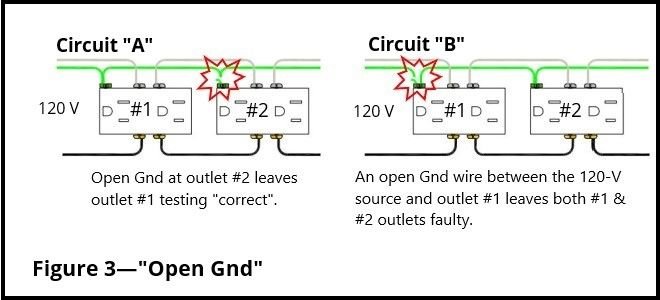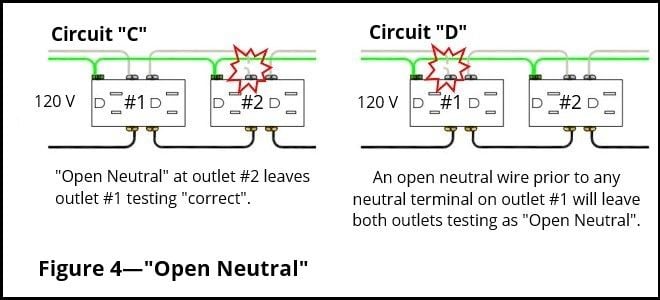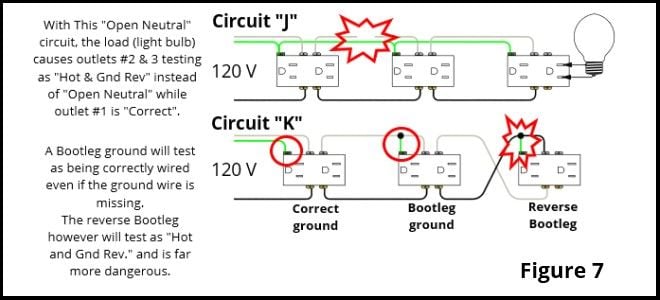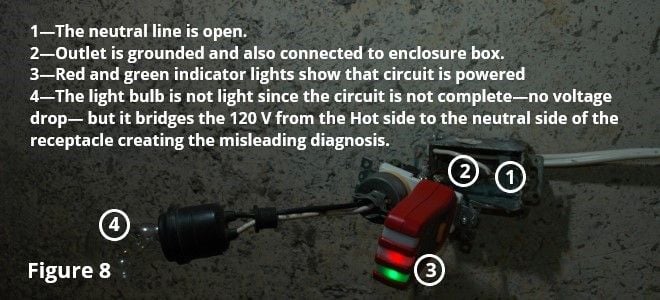What Does It Mean to Make a Connection in Reading
"Hot and ground reversed" is but 1 of the many diagnostic readings that tin exist indicated by an outlet/receptacle tester (Figure 1) . It usually indicates the absenteeism or malfunction of a neutral conductor somewhere in your system.
If you lot receive a Hot/Grd. Reverse reading, check your neutral conductors. One of them might be burned out, requiring replacement, or simply loose, in need of a gentle tightening.
A few different kinds of situation tin can trigger such a reading, however. To get a more than complete picture show of receptacle test results, check out the info below.

The tester is only an instrument that reads the relationship between the hot, the neutral, and the ground wires at specific receptacles inside a excursion and a miswired receptacle volition not necessarily be reflected into all the other outlets within that excursion.
When the "correct" reading isn't shown past the proper lights sequence on the receptacle tester, the lights that do come on will bespeak the probable cause relative to the faulty wiring, caused by broken or mixed-upwardly wires, or wires attached to wrong terminal screws. The error, however, might be at a dissimilar location within that excursion and some tracking could be required forth the line to find its origin. While doing electrical piece of work, at that place'due south also the possibility that a combination of multiple faults results in misdiagnosis. The following is a progressive write-upwardly describing every possible diagnosis and all their possible causes.
Figure 2 describes all the outlets in the following circuits, showing 2 outlets, each with three openings—one short slot continued to the hot terminal, one longer slot continued to the neutral terminal (providing the render path), and the semi-round ground opening matched to the dark-green ground terminal merely also continued to the metallic enclosure box.
ane. Open Ground (Gnd)
Figure 3 shows two circuits with the same problem but in different locations. Although the flaw is practically unnoticeable without a tester, a break (or a loose connection) in the basis wire at either location does not prevent an appliance from working when plugged into information technology, merely it does create a serious electrocution hazard from outlets #2 in circuit A and from both receptacles in circuit B should a short circuit occur while the open footing situation exists.

An "Open Ground" reading is often the result of someone forgetting to connect the wire to the light-green last screw, or a broken basis wire, causing the post-obit results—
i.ane—A multimeter not showing any voltage between the Hot and the Ground terminals at outlet #ii of circuit A and at neither outlet in circuit B simply reading 120 Volts at outlet #1 in circuit A.
1.2—The multimeter showing 120 volts between the Hot and the white Neutral connectors on all the outlets.
ane.3—An outlet tester's lights showing "Open Footing" on outlets #2 in circuit A and both outlets in excursion B, and "Correct Wiring" when plugged into Outlet #1 in circuit A.
A word of circumspection—A physical connexion must besides ground the enclosure box to the receptacle'southward ground last.
2. Open Neutral
In Effigy four , circuit C has ability in outlet #one but none at outlet #two nor is in that location any ability at all in circuit D. Check for a broken or loose wire connection on one of the white leads at the specified points (inside the red star) in circuits C and D.

Testing the receptacles will effect in one of the following:
2.1—No voltage showing betwixt the Hot and the Neutral terminals in either outlets #1 or #2 of circuit D or outlet #2 of circuit C, but the multimeter would read 120 volts at outlet #1 in circuit C.
2.2—A 120 Volts reading between the Hot and the basis at any of the outlets of both circuits C and D.
ii.3—A 120 Volts reading between the Hot and the Neutral at outlet # i of circuit C merely.
ii.4—The outlet tester showing an "Open Neutral" on outlets #one in circuit D besides as in outlets #2 in both circuits C and D, and "Correct Wiring" when plugged into outlet #1 in circuit C.
Notation: An appliance would work on outlet #ane in excursion C just non on any of the other outlets.
2.5—In i special instance, "Open Neutral" can easily become a "Hot and Ground Reversed" as highlighted in section "5—Hot & Gnd Rev".
3. Open Hot
With no lights on the tester at outlet #2 in circuit E or anywhere in excursion F, except for outlet #1 in circuit E that tests "Correct", the Hot wire is open up past the last outlet that lights information technology upward—it could even be on the outfeed wire of that outlet—or before outlet #1 of circuit F (Figure 5).

four. Hot & Neutral Reversed
Figure 6 shows two circuits with an unconventional mix up of wires at some outlets. This frequently happens when adding receptacles to existing circuits, and it DOES provide voltage (although unsafe) to all the receptacles, along with the following results—

4.i—The receptacle tester volition only show "Correct wiring" on outlets # three of circuit G and outlets # 1 & 4 of circuit H.
iv.2—A multimeter volition testify 120 Volts across the Hot and the Neutral terminals of ALL the outlets.
four.3—A multimeter will show 120 volts between the Hot and the Gnd terminals on outlet #3 in circuit 1000 and outlets #1 & 4 in circuit H.
4.four— The multimeter volition non show any voltage between the Hot and the Gnd terminals on outlets #1 & 2 of circuit Grand and outlets #2 & 3 of excursion H, simply 120 Volts between the Neutral and Gnd terminals making these outlets lethally hazardous by placing a live voltage on every grounded part of all appliances plugged into information technology.
5. Hot & Ground Reverse
This contradicting statement implies that the ground wire is energized with 120 volts while the hot wire is grounded, which would create a brusque circuit! But as illustrated in Figure 7 , there are some wiring configurations that, without shorting out, can cause the receptacle tester to give a "Hot & Gnd reverse" consequence.

5.1—Such a situation could occur as in Figure eight, with an open neutral line upstream of the faulty receptacle (towards the panel) while a load such every bit a lamp was plugged into that receptacle or some other receptacle downstream (farther down the line). The open line would prevent the current from flowing, keeping the light bulb from lighting. The light, therefore, can't cause a voltage driblet, but does create an interconnection betwixt the hot and the neutral slots of the outlet energizing the two of them at 120 volts, which the receptacle tester identifies as "Hot & Ground Reverse."

5.ii—A "bootleg" footing situation is oftentimes nowadays in older installations before safer electrical installations that included a ground wire existed. With the absence of the ground wire within the circuit, the receptacle'southward basis final is connected to the neutral—which is a code violation. A standard receptacle tester cannot notice a Homemade basis reporting it as correctly wired or "correct".
The do is unsafe and less dangerous, withal than the "reverse bootleg", where the hot and the neutral wires get mixed upward ending up on the incorrect terminals with the ground terminal connected to the Hot instead of the neutral wire (Effigy 7) and creating the same chance as described in section iv.4.
So armed with all this info and a receptacle tester, y'all're now ready to brand your abode a safer identify.
griffinsamesessuld.blogspot.com
Source: https://www.doityourself.com/stry/what-does-a-hot-ground-reverse-reading-mean
Post a Comment for "What Does It Mean to Make a Connection in Reading"